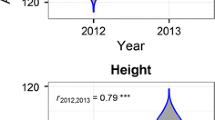Abstract
In recent decades, most winter wheat (Triticum aestivum L.) breeding in the United States has been done in field nurseries in which the soil receives ample fertilization. To determine the effects of these breeding efforts on productivity under low-fertility conditions, we evaluated twenty-nine winter wheat genotypes (seven Asian landraces; thirteen standard-height U.S. cultivars released between 1874 and 1971; and nine semidwarf cultivars released between 1977 and 1988) under severe fertility stress at three Kansas, USA locations. Experiments included fertilized and unfertilized treatments. The modern, semidwarf cultivars yielded 18% and 20% more, on average, than landraces and standard-height cultivars under low and high fertility, respectively; however, only the latter difference reached the 5% significance level. At only one location (Hays) was there a significant genotype X fertility interaction: there, 89% of the semidwarf cultivars, only 8% of the standard cultivars, and 57% of the landraces responded to fertilization. The regression coefficient of mean grain yield (unfertilized) on year of introduction or release for standard and semidwarf cultivars was zero, indicating that a century of breeding has produced no genetic improvement in performance under these low-fertility conditions. Although we found that the usual yield advantage of modern cultivars is not expressed under very low fertility, we saw no evidence that older cultivars are superior under those conditions.
Similar content being viewed by others
References
Austin, R.B., M.A. Ford & C.L. Morgan, 1989. Genetic improvement in the yield of winter wheat: a further evaluation. J. Agric. Sci. Camb. 122: 295–301.
Bramel-Cox, P.J., T. Barker, F. Zavala-Garcia & J.D. Eastin, 1991. Selection and testing environments for improved performance under reduced-input conditions. In: P.J. Bramel-Cox & T. Barker (Eds.), Plant Breeding and Sustainable Agriculture: Considerations for Objectives and Methods, pp. 29–56. CSSA Special Publication no. 18, Crop Science Soc. America, Madison, WI, USA.
Ceccarelli, S. & S. Grando, 1991. Selection environment and environmental sensitivity in barley. Euphytica 57: 157–167.
Cox, T.S., J.P. Shroyer, L. Ben-Hui, R.G. Sears & T.J. Martin, 1988. Genetic improvement in agronomic traits of hard red winter wheat cultivars from 1919 to 1987. Crop Sci. 28: 756–760.
Evans, L.T. & S.K. De Datta, 1979. The relation between irradiance and grain yield of irrigated rice in the tropics, as influenced by cultivar, nitrogen fertilizer application, and month of planting. Field Crops Research 2: 1–17.
Goodman, M.M., 1993. Choosing germplasm: the key to breeding program success. In: M.B. Callaway & C.A. Francis (Eds.), Crop Improvement for Sustainable Agriculture Systems. University of Nebraska Press, Lincoln, NE, USA (in press).
Hetrick, B.A.D., G.W.T. Wilson & T.S. Cox, 1993a. Mycorrhizal dependence of modern wheat varieties, land races, and ancestors. Can. J. Bot. 70: 2032–2040.
Hetrick, B.A.D., G.W.T. Wilson & T.S. Cox, 1993b. Mycorrhizal dependence of modern wheat cultivars and ancestors: a synthesis. Can J. Bot. (in press).
Kansas Agricultural Statistics, 1990. Kansas Farm Facts. Kansas State Board of Agriculture. P.O. Box 3534, Topeka, KS, USA, 112 pp.
Muruli, B.I. & G.M. Paulsen, 1981. Improvement of nitrogen use efficiency and its relationship to other traits in maize. Maydica 26: 63–73.
Author information
Authors and Affiliations
Rights and permissions
About this article
Cite this article
Shroyer, J.P., Cox, T.S. Productivity and adaptive capacity of winter wheat landraces and modern cultivars grown under low-fertility conditions. Euphytica 70, 27–33 (1993). https://doi.org/10.1007/BF00029637
Received:
Accepted:
Issue Date:
DOI: https://doi.org/10.1007/BF00029637




